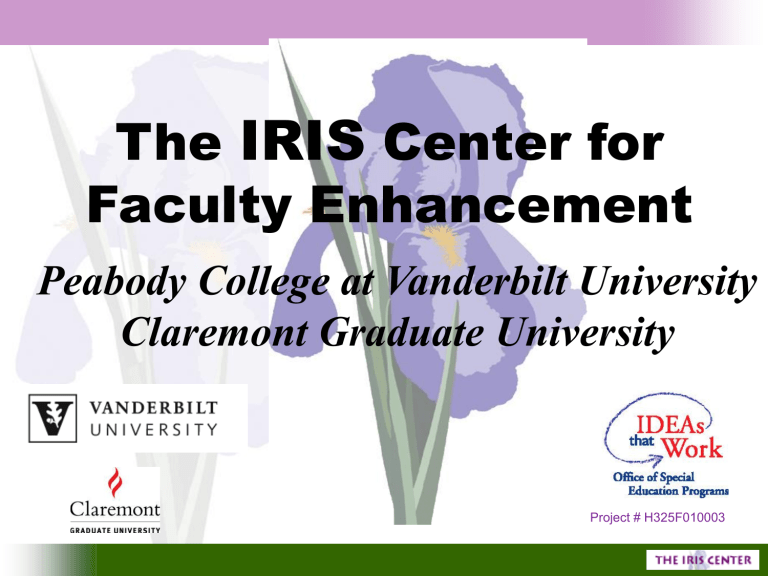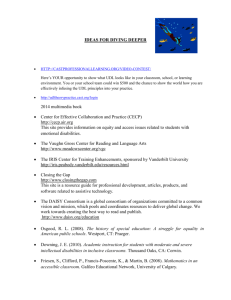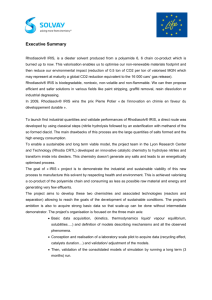The IRIS Center

The
IRIS
Center for
Faculty Enhancement
Peabody College at Vanderbilt University
Claremont Graduate University
Project # H325F010003
The IRIS Center: Free Online Course
Enhancement Materials About Response to
Intervention and the Identification of Students
With Learning Disabilities
Deb Smith, Claremont Graduate University
Naomi Tyler, Vanderbilt University
Kathy Strunk, Tennessee State Dept. of Education
The Reading Dilemma
But, first:
What is IRIS?
and
What does it do?
IRIS (IDEA and Research
For Inclusive Settings)
National Center for Faculty Enhancement
1.Translates research into practice
2. Provides modules and materials for pre-service training
Overarching IRIS purpose:
To assist university faculty to better prepare future non-special education professionals to meet the needs of students with disabilities in inclusive settings.
Why would OSEP invest in a national center?
Reasons for IRIS
Increased inclusion of students with disabilities
2-3 students in EVERY general education classroom will have disabilities
Inner city/urban classrooms where up to half of the class is struggling
Despite years of “mainstreaming” and inclusion, teachers and administrators still report discomfort and lack of knowledge when working with students with disabilities
The IRIS Strategies
Modules not courses
Rich sets of enhancements and resources
The IRIS Strategies
Modules not courses
Rich sets of enhancements and resources
Application of learning sciences
Dissemination without restrictions through technology
The Array of IRIS Materials
Includes:
Modules
Case studies
Other resources
Information Briefs
Student Activities
Web Resource Directories
On-Line Dictionary
IRIS STAR Legacy Modules:
Are grounded in learning sciences
(How People Learn Theories)
IRIS STAR Legacy Modules:
Are grounded in learning sciences
(How People Learn Theories)
Present validated content
(Evidence-based Practices)
The Tennessee Dilemma
•New RTI options of IDEA 2004
•Strong desire and support to implement RTI across TN
•No professional development training materials
TN
TN SIG and OSEP asked IRIS to develop modules on RTI
RTI Content Experts
Lynn Fuchs Doug Fuchs
Vanderbilt University
Sharon Vaughn Thea Woodruff
University of Texas-Austin
Alfredo Artiles
University of Arizona
Larry Wexler
OSEP
Leonard Baca
University of Colorado-Boulder
Basic RTI Module Sequence
Recommended RTI Module Sequence
The Story Line and Characters
Hypothetical School
Rosa Parks Elementary School
S-Team Members
Mr. Johnson – school psychologist
Mrs. Hernandez – 1 st grade teacher
Ms. Johnson – reading specialist (Tier 2 )
Ms. Jacobs – SE teacher
Our Struggling Readers
Megan is monitored in
Tier 1 and shows improvement.
LaToya and Ryan receive Tier 2 services.
They show some progress after 12 weeks, but they continue with
Tier 2 instruction.
DeJuan receives Tier 2 services, after 12 weeks he shows improvement and Tier 2 services are discontinued.
And, then there’s Jack!
Practice with the RTI
Overview Module: 15 minutes
QuickTime™ and a
TIFF (Uncompressed) decompressor are needed to see this picture.
Practice with the RTI
Assessment Module: 15 minutes
QuickTime™ and a
TIFF (Uncompressed) decompressor are needed to see this picture.
Overview of the RTI Reading
Instruction Module: 10 minutes
QuickTime™ and a
TIFF (Uncompressed) decompressor are needed to see this picture.
IRIS Research and Evaluation:
Field-test data
Study 1: Module use, self-reports
Study 2: Module use, learner outcomes
100
Study 1: Student Self-Reports
– For 17 different modules
– From 898 students in courses taught by 16 faculty at 5 institutions
• 47% are majoring in Elementary Education and 31% in Middle and Secondary Education
• 61% are White, 29% are Hispanic, 8% are Asian, and 1% are Black
I learned a lot
I learned fundamental principles
It encouraged me to ask my own questions
I gained factual knowledge
I learned to apply course material
80
60
40
20
0
D is ru p ti ve
B eh a v io rs
C o n te n t
S tr a n d s
E ff e ct iv e
S c h o o l P ra ct ic es
F o c u s o n
t h e p la y b o o k
S u p p o rt in g
T e ac h er s
T e ac h er s
a t th e
L o o m
Module
V is io n
W h at
d o
Y o u
S e e
?
W h o
's
in
C h a rg e?
Y o u
'r e
in
C h a rg e
Study 2: Learner Outcomes
Learning Outcomes
Instructor 1 Instructor 2
13
12
11
10
9
8
7
6
5
2
1
0
4
3
Pretest Posttest
No module
Module as independent assignment
Module with Challenge introduced in class
13
12
11
10
9
8
7
3
2
1
0
6
5
4
Pretest Posttest
7
6
5
4
9
8
3
2
1
0
13
12
11
10
Instructor 3
Pretest Posttest p<.0001 with these variables accounted for:
Textbook content, lectures, time and day of class
The IRIS Center Web Site
User or Visitor
(Not “Hit”)
Data
Number of Visitors to the IRIS Web Site
180000
160000
140000
120000
100000
80000
60000
40000
20000
0
35242
55465
99268
8122
Fall 2004 Spring 2005 Summer 2005 Fall 2005
Number of Visitors
Per academic term.
Exclusive of all Vanderbilt use, research participants, Allyn & Bacon MyLabSchool
163891
Spring 2006
IRIS Center for Faculty Enhancement
Peabody College • Vanderbilt University
Peabody Box 160
Nashville, TN 37203
Claremont Graduate University (CGU)
925 No. Dartmouth
Claremont, CA 91711
(615) 3436006 Phone • (615) 343-5611 Fax
1(866) 626-IRIS (4747) Toll Free http://iris.peabody.vanderbilt.edu/






